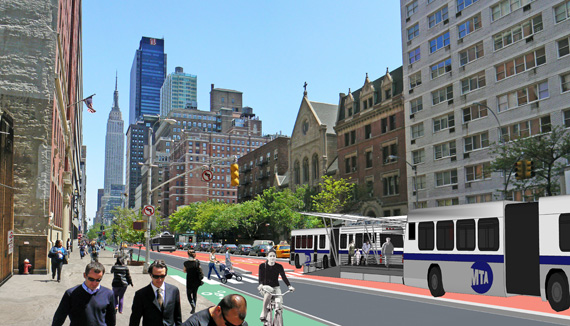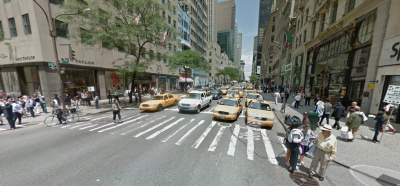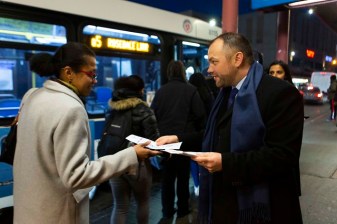NYC’s Next Four Years: From Good Enough to Great
Mayor Bloomberg has already shown how much his administration can accomplish in just a few years. Since Janette Sadik-Khan’s appointment to head the DOT in 2007, the city has striped hundreds of miles of bike lanes, reclaimed acres of street space for pedestrians and improved bus travel for tens of thousands of New Yorkers. “More of the same” is no longer a dirty phrase when it comes to local transportation policy. During the next four years, the mayor needs to accelerate this progress, and introduce a few key innovations to maximize the value New Yorkers get from their new streets.
 There is plenty of room to build on the Bloomberg administration’s record of support for safer, greener streets. Photosim of 34th Street: Luc Nadal and Marc De Decker, ITDP.
There is plenty of room to build on the Bloomberg administration’s record of support for safer, greener streets. Photosim of 34th Street: Luc Nadal and Marc De Decker, ITDP.Whether you’re a straphanger, a cyclist, or a driver, every trip begins and ends with a walk. Pedestrians have had it good in recent years: Public plazas are sprouting by the dozen, hundreds of intersections have safer sidewalks and crossings, and the city’s blueprint for sustainability, PlaNYC, promises that many more improvements are coming soon. How should New York keep this momentum going?
Well, the release of DOT’s Street Design Manual back in July was an especially auspicious development. This groundbreaking playbook contains templates that can transform streets in neighborhoods throughout the five boroughs. The manual is an engineering document, but it also makes sense as an outreach tool. Community groups concerned about street safety could use the manual as a menu, requesting traffic calming solutions for their neighborhood from DOT. Liberal use of these new designs, applied through a smart community-based process, could pay huge dividends all over the city.
For a fraction of the cost of subway line construction, buses could move millions, if the mayor throws his weight behind BRT.
Our city’s new public spaces and calmed streets won’t live up to their potential, though, unless New Yorkers know their roadways are safe places to walk and bike. Under Commissioner Ray Kelly, the NYPD has reduced levels of violent crime to record lows. Law enforcement should tackle traffic crime with equal diligence. Zero tolerance for speeding and dangerous driving, more comprehensive reporting and analysis of traffic crashes, and a relentless advertising campaign — similar to the one the Mayor used to take on smoking — would tame the Wild West atmosphere on our streets. If Bloomberg and Kelly successfully drive down traffic crime, hundreds of lives could be saved, thousands of injuries prevented, and countless New Yorkers would get out and enjoy their city more.
One sensible way for the NYPD to roll out this approach to traffic enforcement would be to start in areas frequented by children and seniors. Seniors make up 12 percent of New York’s population, yet account for 39 percent of pedestrian fatalities. And according to the Department of Health, auto traffic is the leading cause of injury-related death in children ages 1-14. DOT’s Safe Routes to School and Safe Routes for Seniors programs have spawned imitators around the country, but our city is no longer the national leader. Other cities are now far ahead of New York when it comes to implementing these street safety programs. Combined with police enforcement, short-term and inexpensive improvements such as leading pedestrian intervals, reductions in signalized crossing speeds, and a citywide slower speed limit in school zones would prioritize pedestrians, save the lives of children and seniors, and get New York City back in the forefront of planning streets for safety.
Greater safety helps more New Yorkers feel at ease riding on our streets. As the city’s bike network matures, a large-scale public bike-share system is a no brainer. Bike-sharing weaves cycling into the larger transportation network. In Paris, Velib tripled cycling in a few months with 20,000 bikes spread over 1,400 stations. Montrealers took more than a million rides on Bixi in fewer than six months, and similar gains have been repeated around the globe. The same explosive growth would happen in New York overnight, if Mayor Bloomberg backed bike-share in a big way. Seventy-four percent of trips here are five miles or less, meaning they’re very bikeable and easily converted to bike-share trips. If he builds it, they will come.
The same is true of new and better bike facilities. Since the city installed the Ninth Avenue cycle track, biking on the West Side has gotten safer, and so has walking. In Brooklyn, the Kent Avenue protected path is having an identical effect. Traffic-protected bike lanes on Queens Boulevard, through upper Manhattan, down the Upper West Side, and all along the East Side — where there is a dearth of safe space for cyclists — would encourage thousands more New Yorkers to ride.
Mayor Bloomberg is a MetroCard guy, but it’s much easier to spot him on the subway than riding the bus. That should change in the next four years. Although 2.4 million people ride New York City Transit buses each weekday, the bus system is the city’s most underperforming transportation resource. Improvements like pre-paid boarding and signal priority, which have been installed along Fordham Road in the Bronx, could speed service on bus routes around the city. And a true Bus Rapid Transit network, with dedicated lanes for buses and level boarding for passengers, would add another dimension to our transit system. For a fraction of the cost of subway line construction, buses could move millions, if the mayor throws his weight behind BRT.
Mayor Mike has a lot on his plate in the coming weeks, months and years. But if he wants to keep New York City moving toward a sustainable future and shore up his legacy as the Livable City mayor, then safer streets, robust bike-share and better buses are the fastest way to get there.

